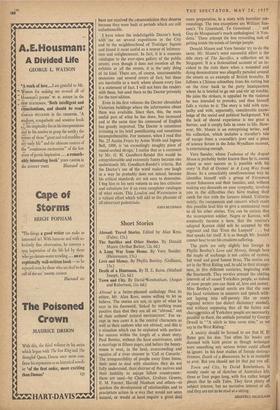London Pleasure
The Buildings of England. London, Vol. 1. The Cities of London and Westminster. By Nikolaus Pevsner. (Pelican, 15s.)
THERE is plenty of information, indeed rather too much, about most buildings in Britain which were built before 1714. This is to be found in -such monumental works as the volumes of the Royal Historical Monuments Commission and the Vic- toria County Histories. In addition to these there is a guide-book lore which has been handed on in slightly different words from 'generation to generation for the last hundred years, from which truth has to be -sifted. There are also specialist books on certain aspects of churches, and on plate, and railways, and scratch dials and Neolithic earthworks. There is a mass of facts about buildings later than the 1714 Plimsoll line recently raised to 1840, and these are buried in technical journals.
When Dr. Pevsner came to London he was shocked by the absence of any systematic and comprehensive catalogue of all this information arranged in regional• form under counties. He set himself to remedy what he considered a defect, but, as so often happens when a series of books is planned, the character has changed slightly with each volume. The latest volume in the series which covers the Cities of London and West- minster is more interesting and useful than its predecessors because the antiquarian and archaeological information taken from already fairly easily obtainable sources is outweighed by information on buildings of the nineteenth and twentieth centuries whose architects and dates have hitherto either lain forgotten in back num- bers of the Builder and such sources or been resuscitated in specialist works by such excellent authors as H. S. Goodhart-Rendel and Professor Hitchcock. It is proper that a new guide-book to London instead of copying out the old informa- tion should mention the principal buildings in main streets in London and Westminster of all dates. The Doctor wisely draws attention to neglected and splendid buildings like Colcutt's Palace Theatre and F. W. Troup's Blackfriars House, to name only two of hundreds which his useful book rediscovers for us. For years they have not received the commendation they deserve because they were built at periods which are still unfashionable.
I have taken the indefatigable Doctor's book with me on several expeditions in the City and in the neighbourhood of Trafalgar Square and found it most useful as a source of informa- tion and enlightenment. In fact, it is a museum catalogue to the ever-open gallery of the public streets; even though it does not mention all the exhibits or all the streets, it is the only thing of its kind. There are, of course, unaccountable omissions and several errors of fact, but these are inevitable in a work where almost every line is a statement of fact. I will not bore the readers with these, but send them to the Doctor privately for the next edition.
Even in his first volumes the Doctor chronicled Victorian buildings where the information about them was available. Since then, this, the most useful part of what he has done, has increased and at the same time his command of English has greatly improved. The Doctor is sometimes irritating in his brief pontificating and sometimes incomprehensible. For instance, when I read that No. 23 Austin Friars by Aston Webb and Ingress Bell, 1888, is `an exceedingly naughty piece of round-arched design,' I realise that as a comment by Mr. G. H. Goodhart-Rendel this would be comprehensible and extremely funny because one understands Mr. Goodhart-Rendel's criteria. But the Doctor's use of the word makes one laugh in a way he probably does not intend, because his critical standards are not easy to determine. I beg him in his next volume to use less criticism and substitute for it an even completer catalogue of what exists. This London and Westminster is a valiant effort which will add to the pleasure of all observant pedestrians.
JOHN BETJEMAN































 Previous page
Previous page